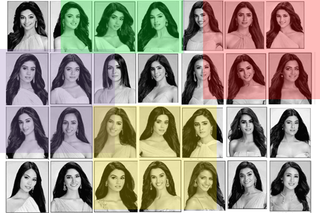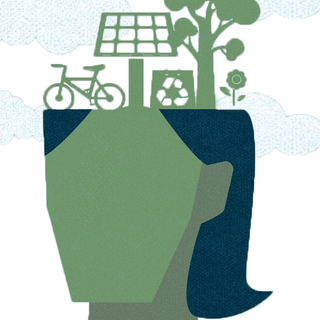
How Will Judges Pick a Miss India 2019? They All Look The Same
The eligibility requirements impose an oppressive standard of beauty.

It’s that time of the year again — the country’s crown and jewels, in the form of painfully put-together women, take the stage to parade around their unnaturally glossy hair, plastered doll-like smiles and carefully-sculpted bodies. I have a serious concern for those judging them though: how will they choose just one? These contestants are all slightly different versions of the same woman. And when I say slightly different, I mean their clothes might be a different color, or maybe they’ll don different-sized heels.
Seriously, a spread of finalized fbb Colors Femina Miss India 2019 pageant contestants from all 30 states looks almost dystopian — they all have the same hair, you know, the kind Aishwarya Rai sports in L’oreal advertisments, as if a CGI demon is hiding underneath holding the impossible looking waves in place; the same skin, either because the judges, Dia Mirza and Neha Dhupia, only chose fair-ish looking women, or the make-up artists employed by the pageant are freakishly dedicated to adhering to euro-centric beauty standards. Put big sunglasses on their faces and I doubt even their family members could tell them apart.
Currently, the eligibility criteria require women to be between 18 and 25 years old. 26- and 27-year-olds can only compete to be runners-up, mind you. 25 is when the pre-frontal cortex fully develops in a person, when they are responsibly able to make good judgments and comprehend the lasting consequences of their actions; maybe the pageant organizers caught on to the fact that not many women over 25 would want to participate in this regressive facade. Eligible women need to be 5 feet 5 inches, or taller — nevermind the average height of an Indian woman is 5 feet. The criteria also state that contestants must be unmarried and childless. This is interesting in a country where the average age at the time of marriage is 22 for women, and where there is enormous social pressure for young women to marry in their early twenties. What does marital status have to do with beauty, anyway, one might ask? Absolutely nothing, except that singledom connotes sexual availability to the viewer, perhaps. These criteria reflect back to society’s basest, most crass, and narrow interpretations of female beauty: a woman who is old enough to be considered legally an adult, but still young enough to look overtly youthful, so tall that they are genetically freaks of nature, unencumbered by the duties of marriage, totally sexually available, and –god forbid — clearly not burdened by the ugliness of motherhood.
Related on The Swaddle:
The Shame and Scandal of Indian Women’s Hair Follicles
An entry form obtained by The News Minute for the 2017 competition describes some more laughably unquantifiable, and insulting, requirements: “The applicant should be a natural born female,” is one. What does it matter what genitals a woman is born with? It shouldn’t matter in any circumstances but this is a beauty pageant, folks. Everything here operates on a superficial level. “Only persons of good health, sound mind and having no medical history of any mental illness,” is another. Honestly, anybody with an iota of self-awareness would go berserk in the pompous environment these stuffy conservatives want to create for women. And top it all off, “and having a good moral character can participate made herein,” is the last of the stipulations. What do they want? Virgins? Women who don’t swear? Don’t eat? Don’t shit? Or are all of these things okay as long as they’re staunch supporters of world peace?
Don’t get me wrong: this is not an attempt to drag these women, who I’m sure are lovely and only trying to get ahead, maybe follow in the footsteps of former beauty queens who went on to get their big break in Bollywood. Safe to say, getting used to the homogenization of their faces can only help their careers as actresses in the Indian film industry. And who here isn’t crippled by the imposition of impossible beauty standards anyway? But when institutions – especially those historically regarded as the purveyors of beauty — fail to incorporate the increasingly in-your-face body positivity movements rocking the world into their message, it feels like we’re flunking the easiest test our society can take to appear more inclusive for young girls.
The beauty pageant is a deeply entrenched societal phenomenon. It has, for decades, pervaded our homes and made us wish we had a different face, a better body. And like clockwork, network executives have fueled that addictive envy, year after year. You might ask: what could we possibly expect from a regressive beauty pageant? Lots, actually. It’s a popular destination where young girls go to see a certain kind of beauty rewarded. While eradicating beauty pageants altogether and creating a post-beauty world might seem far away now, in the face of such resignation, the least we could do is take a minuscle first step and hold such institutions accountable, ask them to atleast diversify what they consider beautiful.
Related on The Swaddle:
What Keeps Many Girls From Loving Their Bodies
It’s the socially responsible thing to do, but inculcating inclusivity is also in the pageant makers’ interest. Take the Victoria’s Secret annual fashion show, for instance. The brand has been consistently disparaged for the rigid beauty standards it imposes on models, which ultimately resulted in the show’s viewership dropping from 9.7 million in 2013 to 3.3 million this year, the New York Times reported. The article further quotes Ed Razek, chief marketing officer of Victoria’s Secret’s parent company, who said in a Vogue interview in 2018, “So it’s like, why don’t you do 50? Why don’t you do 60? Why don’t you do 24?,” referring to body sizes. “It’s like, why doesn’t your show do this? Shouldn’t you have transsexuals in the show? No. No, I don’t think we should. Well, why not? Because the show is a fantasy. It’s a 42-minute entertainment special.” Following the outrage that his comments caused on social media, Victoria’s Secret announced that the show would no longer be playing on network television, and that they would have to rethink the entire concept.
In an era where brands are being lauded for being inclusive in terms of race, size, age, and gender, with 2019’s Fashion Weeks across the globe being the most diverse yet, it is not in the interest of corporations to uphold traditional, oppressive beauty standards.
Sure, the beauty pageant is a fantasy, as Victoria’s Secret’s Razek said. But we are fantasizing about a lot of different-looking people. Let’s give the people what they want.
Rajvi Desai is The Swaddle's Culture Editor. After graduating from NYU as a Journalism and Politics major, she covered breaking news and politics in New York City, and dabbled in design and entertainment journalism. Back in the homeland, she's interested in tackling beauty, sports, politics and human rights in her gender-focused writing, while also co-managing The Swaddle Team's podcast, Respectfully Disagree.
Related


Despite Education Gains, STEM Women in India Still Face Unequal Field
